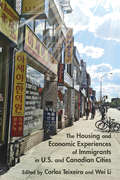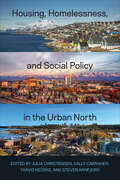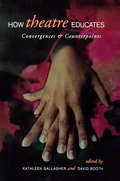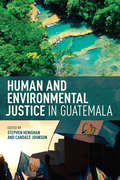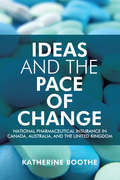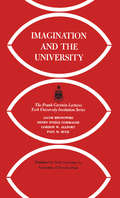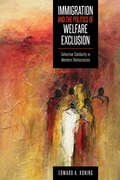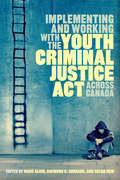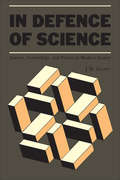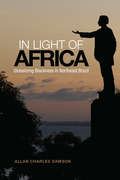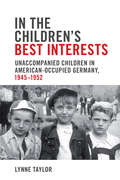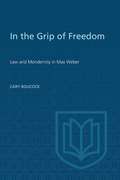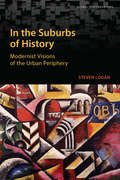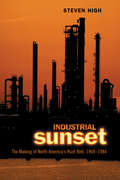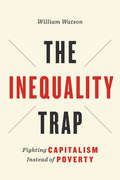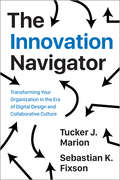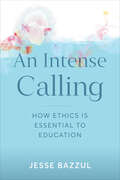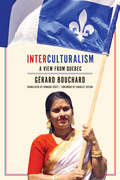- Table View
- List View
The Housing and Economic Experiences of Immigrants in U.S. and Canadian Cities
by Carlos Teixeira Wei LiSince the 1960s, new and more diverse waves of immigrants have changed the demographic composition and the landscapes of North American cities and their suburbs. The Housing and Economic Experiences of Immigrants in U.S. and Canadian Cities is a collection of essays examining how recent immigrants have fared in getting access to jobs and housing in urban centres across the continent.Using a variety of methodologies, contributors from both countries present original research on a range of issues connected to housing and economic experiences. They offer both a broad overview and a series of detailed case studies that highlight the experiences of particular communities. This volume demonstrates that, while the United States and Canada have much in common when it comes to urban development, there are important structural and historical differences between the immigrant experiences in these two countries.
Housing, Homelessness, and Social Policy in the Urban North
by Julia Christensen Sally Carraher Travis Hedwig Steven ArnfjordHousing, Homelessness, and Social Policy in the Urban North brings together leading scholars on northern urban housing across the Canadian North, Alaska, and Greenland. Through various case studies, the contributors examine the ways in which housing insecurity and homelessness provide a critical lens on the social dimensions of northern urbanization. They also present key considerations in the development of effective and sustainable social policy for these areas. The book kickstarts a conversation between multiple stakeholders from different cultural and national regions across the North American north. It asks key questions including these: What are the common problems of, and responses to, housing insecurity and homelessness across these northern regions? Is a single definition of “homelessness” even possible, or desirable? And if not, can a shared language around how to end the housing crisis and homelessness in our northern regions still occur? The contributors explore how experiences of northern towns and cities inform an overall understanding of urban forms and processes in the contemporary world, and speak directly to the emerging body of literature on cities. Highlighting key limitations to federal, state, and provincial policy, Housing, Homelessness, and Social Policy in the Urban North raises important implications for developing policy that is responsive to northern realities.
How Theatre Educates
by Kathleen Gallagher David BoothCanada boasts a remarkable number of talented theatre artists, scholars, and educators. How Theatre Educates brings together essays and other contributions from members of these diverse communities to advocate for a broader and more inclusive understanding of theatre as an educative force.Organized to reflect the variety of contexts in which professionals are making, researching, and teaching drama, this anthology presents a wide range of articles, essays, reminiscences, songs, poems, plays, and interviews to elucidate the relationship between theatre practice and pedagogy, and to highlight the overriding theme: namely, that keeping 'education' - with its curriculum components of dramatic literature and theatre studies in formal school settings - separate from 'theatre' outside of the classroom, greatly diminishes both enterprises.In this volume, award-winning playwrights, directors, actors, and scholars reflect on the many ways in which those working in theatre studios, school classrooms, and on stages throughout the country are engaged in teaching and learning processes that are particular to the arts and especially genres of theatre. Situating theatre practitioners as actors in a larger socio-cultural enterprise, How Theatre Educates is a fascinating and lively inquiry into pedagogy and practice that will be relevant to teachers and students of drama, educators, artists working in theatre, and the theatre-going public.ContributorsMaja ArdalDavid BoothPatricia CanoDiane FlacksKathleen GallagherJohn GilbertSky GilbertJim GilesLinda GriffithsTomson HighwayJanice HladkiCornelia HooglandAnn-Marie MacDonaldLori McDougallJohn MurrellDomenico PietropaoloWalter PitmanRichard RoseJason ShermanLynn SlotkinLarry SwartzJudith ThompsonGuillermo VerdecchiaBelarie Zatzman
Human and Environmental Justice in Guatemala
by Stephen Henighan Candace JohnsonIn 1996, the Guatemalan civil war ended with the signing of the Peace Accords, facilitated by the United Nations and promoted as a beacon of hope for a country with a history of conflict. Twenty years later, the new era of political protest in Guatemala is highly complex and contradictory: the persistence of colonialism, fraught indigenous-settler relations, political exclusion, corruption, criminal impunity, gendered violence, judicial procedures conducted under threat, entrenched inequality, as well as economic fragility. Human and Environmental Justice in Guatemala examines the complexities of the quest for justice in Guatemala, and the realities of both new forms of resistance and long-standing obstacles to the rule of law in the human and environmental realms. Written by prominent scholars and activists, this book explores high-profile trials, the activities of foreign mining companies, attempts to prosecute war crimes, and cultural responses to injustice in literature, feminist performance art and the media. The challenges to human and environmental capacities for justice are constrained, or facilitated, by factors that shape culture, politics, society, and the economy. The contributors to this volume include Guatemalans such as the human rights activist Helen Mack Chang, the environmental journalist Magalí Rey Rosa, former Guatemalan Attorney General Claudia Paz y Paz, as well as widely published Guatemala scholars.
Ideas and the Pace of Change
by Katherine BootheCanada is the only OECD country that has universal, comprehensive public hospital and medical insurance but lacks equivalent pharmaceutical coverage. In Ideas and the Pace of Change, Katherine Boothe explains the reasons for this unique situation. Using archival, interview, and polling data, Boothe compares the policy histories of Canada, the United Kingdom, and Australia in order to understand why Canada followed a different path on pharmaceutical insurance.Boothe argues that pace matters in policy change. Quick, radical change requires centralized political institutions, an elite consensus, and an engaged, attentive electorate. Without these prerequisites, states are far more likely to take a slower, incremental approach. But while rapid policy change reinforces the new consensus, incremental progress strengthens the status quo, letting development stall and raising the bar for achieving change.An important contribution to the study of comparative political economy, Ideas and the Pace of Change should be required reading for anyone seeking to understand why health care reforms succeed or fail.
Imagination and the University
by Henry Steele Commager Jacob Bronowski Gordon W. Allport Paul H. BuckThis volume, the Frank Gerstein Lectures for 1963, is the second series of Invitation Lectures to be delivered at York University. The theme "Imagination and the University" was appropriate for, as President Murray Ross states in this Foreword, it is in its early years that a university is sufficiently flexible to utilize imagination in its structure and in its curriculum. York University was in its third year when the Lectures were given.Four distinguished scholars present their views on the importance of an imaginative approach to the different academic disciplines, and to the conduct of life in contemporary society as a whole.Jacob Bronowski, speaking on Imagination in Art and Science, draws a clear and striking analogy between the role of imagination in mathematics and in poetry, drawing on his own experiences and contributions in both areas. He stresses that all creative works in art or science, must conform to the universal experience of mankind and to the private experiences of each man: the work of science, as of art, moves us profoundly, in mind and in emotion, when it matches our experience and at the same time points beyond it.Henry Steele Commager shows how important is the contribution to be made by an imaginative approach to politics, where, as in other fields of human experience, it must not be separated from reality, if it is to find expression in something more than words. He points to examples from the past and the present and asks for more imagination in public thinking, it fit our actions to the reality of change, citing the urgency of such twentieth-century phenomena as the status of Communist China, the predicted population explosion, and the threat of nuclear war. Professor Commager believes that the universities provide the key to this kind of approach, being a supreme example of the creative capacity of mankind, whose function it is to serve the commonwealth of learning.A different kind of insight is offered by Gordon W. Allport, whose subject is Imagination in Psychology. He believes that the present "impertinence" of psychology can best be cured by endowing it with more imagination. He demands a pluralistic approach to psychological investigation, which would not deny the insights yielded by traditional methods, with their characteristic minute analyses, but whose goal would be to fashion a conception of the human person that would exclude nothing that is valid, and at the same time preserve an ideal of rational consistency. This could lead, in turn, to a clear definition of the root motives of mankind, even to discovering new formulas for international peace by offsetting particularistic political demands. Finally, Paul H. Buck describes the Harvard House Plan as an example of Imagination and the Curriculum. This plan, modelled on the Oxford-Cambridge College system which is also followed in some Canadian universities, is an attempt to make all aspects of undergraduate life a process of education. And a truly liberal education for today and tomorrow, Professor Buck is confident, will combine a programme of general education, a programme of specialism, and a collegiate way of living.
Immigrants in Prairie Cities
by Royden Loewen Gerald FriesenOver the course of the twentieth century, sequential waves of immigrants from Europe, Asia, Latin America, and Africa settled in the cities of the Canadian Prairies. In Immigrants in Prairie Cities, Royden Loewen and Gerald Friesen analyze the processes of cultural interaction and adaptation that unfolded in these urban centres and describe how this model of diversity has changed over time. The authors argue that intimate Prairie cities fostered a form of social diversity characterized by vibrant ethnic networks, continuously evolving ethnic identities, and boundary zones that facilitated intercultural contact and hybridity.Impressive in scope, Immigrants in Prairie Cities spans the entire twentieth century, and encompasses personal testimonies, government perspectives, and even fictional narratives. This engaging work will appeal to both historians of the Canadian Prairies and those with a general interest in migration, cross-cultural exchange, and urban history.
Immigration and the Politics of Welfare Exclusion: Selective Solidarity in Western Democracies (Studies in Comparative Political Economy and Public Policy)
by Edward A. KoningWhy do some governments try to limit immigrants’ access to social benefits and entitlements while others do not? Through an in-depth study of Sweden, Canada, and the Netherlands, Immigration and the Politics of Welfare Exclusion maps the politics of immigrants’ social rights in Western democracies. To achieve this goal, Edward A. Koning analyzes policy documents, public opinion surveys, data on welfare use, parliamentary debates, and interviews with politicians and key players in the three countries. Koning’s findings are three-fold. First, the politics of immigrant welfare exclusion have little to do with economic factors and are more about general opposition to immigration and multiculturalism. Second, proposals for exclusion are particularly likely to arise in a political climate that incentivizes politicians to appear "tough" on immigration. Finally, the success of anti-immigrant politicians in bringing about exclusionary reforms depends on the response of the political mainstream, and the extent to which immigrants’ rights are protected in national and international legal frameworks. A timely investigation into an increasingly pressing subject, Immigration and the Politics of Welfare Exclusion will be essential reading for scholars and students of political science, comparative politics, and immigration studies.
Immigration Dialectic
by Harald BauderImmigration is an integral part of national identity in settler societies such as Canada. But in countries where identity is defined more in ethnic terms, such as Germany, the presence of immigrants has only recently begun to be acknowledged. Taking these two countries as case studies, Immigration Dialectic explores the impact of immigration on national identity as imagined through media-based discourse.Harald Bauder argues that while both countries rely on negative depictions of immigrants to construct a positive image of the self, the ways in which Canada and Germany construct national identity in relation to representations of immigrants are significantly different. Bauder introduces a sophisticated framework of Hegelian dialectics for the growing interdisciplinary literature regarding media perspectives on immigration and national identity. Providing close analysis of themes such as belonging, economic impacts, and national security, Immigration Dialectic will appeal to anyone interested in contemporary discussions on immigration.
Implementing and Working with the Youth Criminal Justice Act across Canada
by Marc Alain Susan Reid Raymond R. CorradoSince its implementation in 2003, the Youth Criminal Justice Act has been the subject of intense political and scholarly debate. A complicated mixture of provisions intended to provide harsher punishments for serious violent crimes while encouraging positive, non-punitive interventions in less serious cases, its impact on the youth justice system remains controversial.Implementing and Working with the Youth Criminal Justice Act across Canada provides the first comprehensive, province-by-province analysis of how each Canadian jurisdiction has implemented the Act in accordance with its own history, traditions, and institutional arrangements. Drawing on in-depth interviews with probation officers, counselors, educators, and social workers, the contributors use the experiences of practitioners to offer a new analytical perspective on a complicated and contentious aspect of the Canadian justice system. Their conclusions provide vital policy and program information for researchers, practitioners, and policy makers concerned with Canada's youth justice systems.
In Defence of Science: Science, Technology, and Politics in Modern Society
by Jack GroveScience holds a central role in the modern world, yet its complex interrelationships with nature, technology, and politics are often misunderstood or seen from a false perspective. In a series of essays that make extensive use of original work by sociologists, historians, and philosophers of science, J.W. Grove explores the roles and relationships of science in modern technological society. Modern Science can be viewed from four related perspectives. It is an expression of human curiosity – a passion to understand the natural world: what it is made of, how it is put together, and how it works. It is a body of practice – a set of ways of finding out that distinguish it from other realms of inquiry. It is a profession – a body of men and women owing allegiance to the pursuit of knowledge – and for those people, a career. And it is a prescriptive enterprise in that the increase of scientific understanding makes it possible to put nature to use in new kinds of technology. Each of these aspects of science is today the focus of critical scrutiny and, often, outright hostility. With many examples, Grove exposes the threats to science today: its identification with technology, its subordination to the state, the false claims made in its name, and the popular intellectual forces that seek to denigrate it as a source of human understanding and progress.
In Light of Africa
by Allan Charles DawsonIn Light of Africa explores how the idea of Africa as a real place, an imagined homeland, and a metaphor for Black identity is used in the cultural politics of the Brazilian state of Bahia. In the book, Allan Charles Dawson argues that Africa, as both a symbol and a geographical and historical place, is vital to understanding the wide range of identities and ideas about racial consciousness that exist in Bahia's Afro-Brazilian communities.In his ethnographic research Dawson follows the idea of "Africa" from the city of Salvador to the West African coast and back to the hinterlands of the Bahian interior. Along the way, he encounters West African entrepreneurs, Afrobeat musicians, devotees of the Afro-Brazilian religion Candomblé, professors of the Yoruba language, and hardscrabble farmers and ranchers, each of whom engages with the "idea of Africa" in their own personal way.
In the Children’s Best Interests: Unaccompanied Children in American-Occupied Germany, 1945-1952
by Lynne TaylorAmong the hundreds of thousands of displaced persons in Germany at the end of World War II, approximately 40,000 were unaccompanied children. These children, of every age and nationality, were without parents or legal guardians and many were without clear identities. This situation posed serious practical, legal, ethical, and political problems for the agencies responsible for their care.In the Children’s Best Interests, by Lynne Taylor, is the first work to delve deeply into the records of the United Nations Relief and Rehabilitation Administration (UNRRA) and the International Refugee Organization (IRO) and reveal the heated battles that erupted amongst the various entities (military, governments, and NGOs) responsible for their care and disposition. The bitter debates focused on such issues as whether a child could be adopted, what to do with illegitimate and abandoned children, and who could assume the role of guardian. The inconclusive nationality of these children meant they became pawns in the battle between East and West during the Cold War. Taylor’s exploration and insight into the debates around national identity and the privilege of citizenship challenges our understanding of nationality in the postwar period.
In the Grip of Freedom: Law and Modernity in Max Weber (The Royal Society of Canada Special Publications)
by Cary BoucockFaith in the utility and value of legal rights forms the political common sense of our age. With its profound breadth and insight into the modern condition, Max Weber's social and political thought is widely considered to be the most influential of the era. Legal phenomena play a centre-stage role in his account of the development of the West and the rationalism of modern social arrangements.Cary Boucock's "In the Grip of Freedom" examines the relationship between Max Weber's "Sociology of Law" and his interpretation of the structure and meaning of modern society. Weber's social and political thought is investigated in the context of developments in Canada which have followed the 1982 enactment of the Canadian Charter of Rights and Freedoms-namely, the movement toward a rights-oriented nation where broad social issues are routed through the courts, and the political self-understanding of the citizen becomes increasingly tied to a conception of the individual as a rights-bearing subject. Professor Boucock's text runs against the grain of conventional assessments of Weber's legal theory and its applicability to understanding contemporary legal developments. He explores the significance of Weber's sociology of law theories within the larger compass of his sociological thought and illustrates the significance of Weber's sociology for interpreting the social dimensions of present-day legal developments in Canada. Weber's work is a vehicle for understanding the social and legal practices of our own time, and thus, goes far beyond a simple interpretation of the great German thinker.
In the Suburbs of History: Modernist Visions of the Urban Periphery (Global Suburbanisms)
by Steven LoganIn the 1960s, socialist and capitalist urban planners, architects, and city officials chose the urban periphery as the site to test out new ideas in modernist architecture and planning: the outskirts of Prague and a bedroom suburb of Toronto would be the sites for experimental urban development. In the Suburbs of History overcomes the divisions between East and West to reassemble the shared histories of modern architecture and urbanism as it shaped and re-shaped the periphery. Drawing on archives, interviews, architectural journals, and site visits to the peripheries of Prague and Toronto, Steven Logan reveals the intertwined histories of capitalist and socialist urban planning. From socialist utopias to the capitalist visions of the edge city, the history of the suburbs is not simply a history of competing urban forms; rather, it is a history of alternatives that advocated collective solutions over the dominant model of single-family home ownership and car-dominated spaces.
Incorporating Texts into Institutional Ethnographies
by Dorothy E. Smith Susan Marie TurnerIn Incorporating Texts into Institutional Ethnographies, Dorothy E. Smith and Susan Marie Turner present a selection of essays highlighting perhaps the single most distinctive feature of the sociological approach known as Institutional Ethnography (IE) - the ethnographic investigation of how texts coordinate and organize people's activities across space and time. The chapters, written by scholars who are relatively new to IE as well as IE veterans, illustrate the wide variety of ways in which IE investigations can be done, as well as the breadth of topics IE has been used to study.Both a collection of examples that can be used in teaching and research project design and an excellent introduction to IE methods and techniques, Incorporating Texts into Institutional Ethnographies is an essential contribution to the subject.
Indigenous African Knowledge Production
by Njoki Nathani-WaneThe Jie people of northern Uganda and the Turkana of northern Kenya have a genesis myth about Nayeche, a Jie woman who followed the footprints of a gray bull across the waterless plateau and who founded a "cradle land" in the plains of Turkana. In Remembering Nayeche and the Gray Bull Engiro, Mustafa Kemal Mirzeler shows how the poetic journey of Nayeche and the gray bull Engiro and their metaphorical return during the Jie harvest rituals gives rise to stories, imagery, and the articulation of ethnic and individual identities.Since the 1990s, Mirzeler has travelled to East Africa to apprentice with storytellers. Remembering Nayeche and the Gray Bull Engiro is both an account of his experience listening to these storytellers and of how oral tradition continues to evolve in the modern world. Mirzeler's work contributes significantly to the anthropology of storytelling, the study of myth and memory, and the use of oral tradition in historical studies.
Industrial Ruination, Community and Place
by Alice MahAbandoned factories, shipyards, warehouses, and refineries are features of many industrialized cities around the world. But despite their state of decline, these derelict sites remain vitally connected with the urban landscapes that surround them. In this enlightening new book, Alice Mah explores the experiences of urban decline and post-industrial change in three different community contexts: Niagara Falls, Canada/USA; Newcastle-upon-Tyne, UK; and Ivanovo, Russia.Employing a unique methodological approach that combines ethnographic, spatial, and documentary methods, Mah draws on international comparisons of the landscapes and legacies of industrial ruination over the past forty years. Through this, she foregrounds the complex challenges of living with prolonged uncertainty and deprivation amidst socioeconomic change. This rich comparative study makes an essential contribution to far-reaching debates about the decline of manufacturing, regeneration, and identity, and will have important implications for urban theory and policy.
Industrial Sunset
by Steven HighPlant shutdowns in Canada and the United States from 1969 to 1984 led to an ongoing and ravaging industrial decline of the Great Lakes Region. Industrial Sunset offers a comparative regional analysis of the economic and cultural devastation caused by the shutdowns, and provides an insightful examination of how mill and factory workers on both sides of the border made sense of their own displacement. The history of deindustrialization rendered in cultural terms reveals the importance of community and national identifications in how North Americans responded to the problem.Based on the plant shutdown stories told by over 130 industrial workers, and drawing on extensive archival and published sources, and songs and poetry from the time period covered, Steve High explores the central issues in the history and contemporary politics of plant closings. In so doing, this study poses new questions about group identification and solidarity in the face of often dramatic industrial transformation.
The Inequality Trap
by William WatsonUS President Barack Obama has called economic inequality the "defining issue of our time." It has inspired the "Occupy" movements, made a French economist into a global celebrity, and given us a new expression - the "one percent." But is our preoccupation with inequality really justified? Or wise?In his new book, William Watson argues that focusing on inequality is both an error and a trap. It is an error because much inequality is "good," the reward for thrift, industry, and invention. It is a trap because it leads us to fixate on the top end of the income distribution, rather than on those at the bottom who need help most. In fact, if we respond to growing inequality by fighting capitalism rather than poverty, we may end up both poorer and less equal.Explaining the complexities of modern economics in a clear, accessible style, The Inequality Trap is the must-read rejoinder to the idea that fighting inequality should be our top policy priority.
Inheriting a Canoe Paddle
by Misao DeanIf the canoe is a symbol of Canada, what kind of Canada does it symbolize? Inheriting a Canoe Paddle looks at how the canoe has come to symbolize love of Canada for non-aboriginal Canadians and provides a critique of this identification's unintended consequences for First Nations. Written with an engaging, personal style, it is both a scholarly examination and a personal reflection, delving into representations of canoes and canoeing in museum displays, historical re-enactments, travel narratives, the history of wilderness expeditions, artwork, film, and popular literature.Misao Dean opens the book with the story of inheriting her father's canoe paddle and goes on to explore the canoe paddle as a national symbol - integral to historical tales of exploration and trade, central to Pierre Trudeau's patriotism, and unique to Canadians wanting to distance themselves from British and American national myths. Throughout, Inheriting a Canoe Paddle emphasizes the importance of self-consciously evaluating the meaning we give to canoes as objects and to canoeing as an activity.
The Innovation Navigator: Transforming Your Organization in the Era of Digital Design and Collaborative Culture (Rotman-UTP Publishing - Business and Sustainability)
by Sebastian Fixson Tucker MarionInnovation is a top strategic priority for firms across all industries. In The Innovation Navigator, Tucker J. Marion and Sebastian K. Fixson explore four innovation archetypes or modes – "specialist," "venture," "community," and "network" – which feature prominently in the expanding innovation landscape. Specialists employ technologies to achieve entirely new solutions and superior product performance. New corporate ventures lower the barriers for employees to self-select into entrepreneurial projects, while reducing the constraints of bureaucracy. The community brings new sources of knowledge by expanding past the firm's boundaries, dramatically increasing the number of participants. The network creates partnerships and ecosystems that create innovations that could not be developed by individual companies alone. The Innovation Navigator guides the reader in exploring and exploiting these different modes of innovation. Individual chapters provide key insights into the inherent opportunities and challenges from a number of vantage points: from the impact on organizational resources to the role of incentives. The book also provides a framework for how firms can leverage dynamic mode shifts and multimode strategies. Firms across the industrial spectrum are profiled, from new additive manufacturing companies such as Formlabs, community-based solution providers like Forth, to traditional firms exploring new modes like GE Appliances and their FirstBuild initiative. The Innovation Navigator will assist executives in building the capabilities for peak performance in this new innovation landscape.
An Intense Calling: How Ethics Is Essential to Education
by Jesse BazzulPositing that education is a movement from one way of being to another, more desirable one, An Intense Calling argues that ethics should be the prime focus for the field of education. The book locates ethics, education, and justice in human subjectivity and describes education as a necessary practice for ethical reflexivity, change, and becoming (ethically) different. It also situates ethics as something that exceeds subjectivity, thereby engaging ethics as a material phenomenon through topics such as aesthetics and solidarity with non-humans. Jesse Bazzul explores various concepts in the book including power, biopolitics, the commons, subjectivity, and materiality, and draws from over twenty years of experience teaching in different countries including Canada, Ireland, the United States, China, and Ukraine. Taking a wide-ranging philosophical approach, the book entangles ethics, urgent political issues, and pressing educational contexts of the twenty-first century. In doing so, An Intense Calling maintains that ethics is the core of education because education involves finding better ways of living and being in the world.
Interculturalism
by Howard Scott Charles Taylor Gerard BouchardAccommodating ethnic diversity is a major challenge for all democratic nations and a topic that has attracted a great deal of attention in the last few decades. Within Quebec, a new approach has emerged that seeks a balance between the needs of minorities and those of the majority.In Interculturalism, sociologist and historian Gérard Bouchard presents his vision of interculturalism as a model for the management of diversity. A pluralist approach which recognizes the existence of a cultural majority whose rights must also be acknowledged, interculturalism constitutes an important alternative to multiculturalism both in Canada and internationally. Written by one of Quebec's leading public intellectuals and the co-chair of the Bouchard-Taylor Commission on reasonable accommodation, Interculturalism is the first clear and comprehensive statement in English of an approach being discussed around the world.A translation of Bouchard's award-winning French-language work, L'Interculturalisme: Un point de vue québécois, this book features a new foreword by philosopher Charles Taylor and an afterword by the author written specifically for the English-language edition.
Into the Fire
by Shelley PacholokIn August 2003, one of the largest wildfires in Canadian history struck near Kelowna, British Columbia and the surrounding Okanagan Valley, causing unprecedented damage. As Shelley Pacholok observes in this innovative study, the turbulence and extreme conditions that followed in the wake of this disaster destabilized an important area of social life - that of gender relations.Into the Fire combines insights from gender studies and disaster studies to explore the extent to which notions of "masculinity" and "femininity" are challenged in the wake of crises. Pacholok focuses on how gender relations were simultaneously sustained and disrupted among those who fought the fire, drawing on media representations as well as interviews with firefighters . Into the Fire illuminates how disasters can serve as catalysts for new patterns of gender, even in highly masculine spaces.
